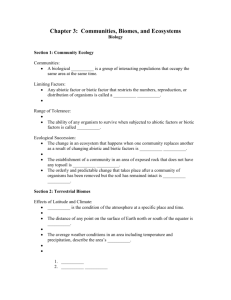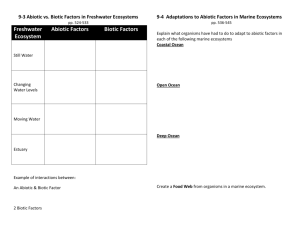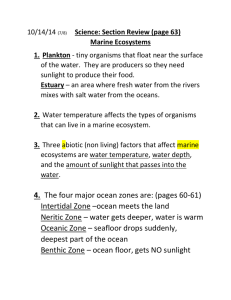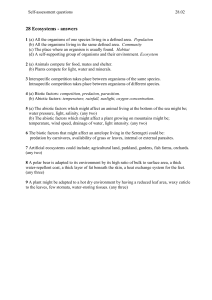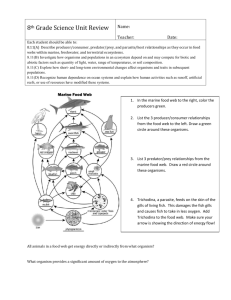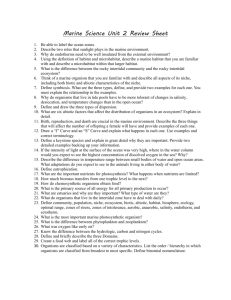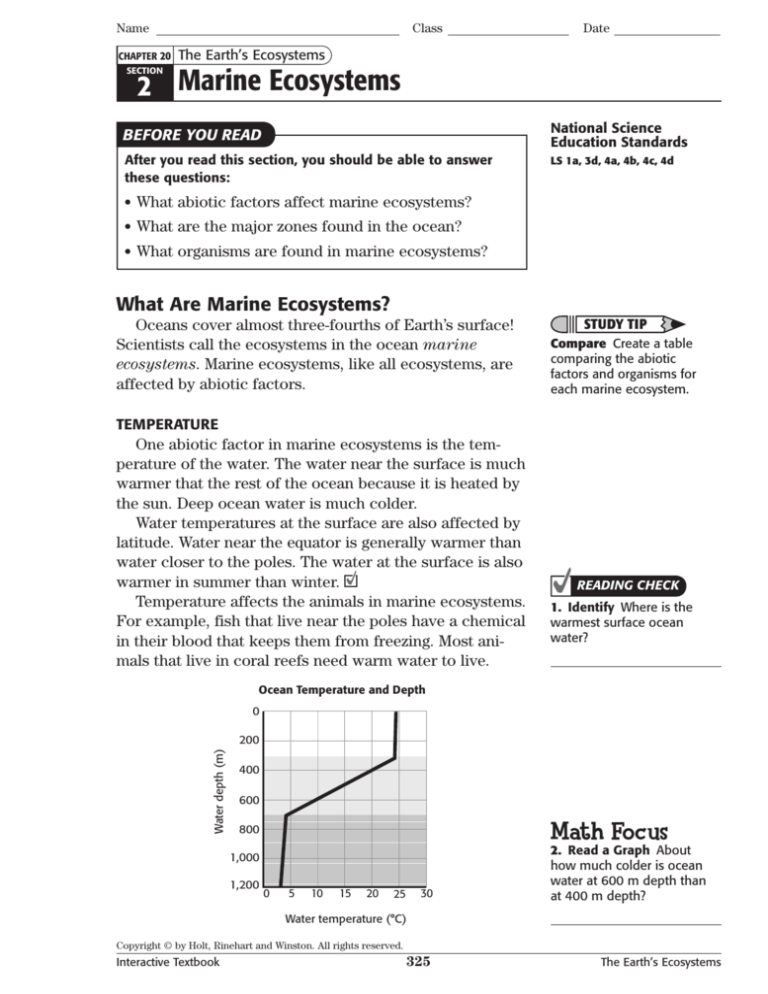
Name
CHAPTER 20
Class
Date
The Earth’s Ecosystems
SECTION
2 Marine Ecosystems
National Science
Education Standards
BEFORE YOU READ
After you read this section, you should be able to answer
these questions:
LS 1a, 3d, 4a, 4b, 4c, 4d
• What abiotic factors affect marine ecosystems?
• What are the major zones found in the ocean?
• What organisms are found in marine ecosystems?
What Are Marine Ecosystems?
Oceans cover almost three-fourths of Earth’s surface!
Scientists call the ecosystems in the ocean marine
ecosystems. Marine ecosystems, like all ecosystems, are
affected by abiotic factors.
STUDY TIP
Compare Create a table
comparing the abiotic
factors and organisms for
each marine ecosystem.
TEMPERATURE
One abiotic factor in marine ecosystems is the temperature of the water. The water near the surface is much
warmer that the rest of the ocean because it is heated by
the sun. Deep ocean water is much colder.
Water temperatures at the surface are also affected by
latitude. Water near the equator is generally warmer than
water closer to the poles. The water at the surface is also
warmer in summer than winter.
Temperature affects the animals in marine ecosystems.
For example, fish that live near the poles have a chemical
in their blood that keeps them from freezing. Most animals that live in coral reefs need warm water to live.
READING CHECK
1. Identify Where is the
warmest surface ocean
water?
Ocean Temperature and Depth
0
Water depth (m)
200
400
600
Math Focus
800
1,000
1,200
0
5
10
15
20
30
25
2. Read a Graph About
how much colder is ocean
water at 600 m depth than
at 400 m depth?
Water temperature (°C)
Copyright © by Holt, Rinehart and Winston. All rights reserved.
Interactive Textbook
325
The Earth’s Ecosystems
Name
SECTION 2
Class
Date
Marine Ecosystems continued
WATER DEPTH AND SUNLIGHT
READING CHECK
3. List What are the three
main abiotic factors that
affect marine ecosystems?
Two other abiotic factors that affect marine ecosystems
are water depth and sunlight. The average depth of the
oceans is 4,000 m, but sunlight does not reach deeper than
200 m. Producers that carry out photosynthesis, such as
algae, can live only in water less than about 200 m deep.
Plankton are tiny organisms that float near the surface
of the ocean. Many kinds of plankton are producers. These
phytoplankton use photosynthesis to make their own food.
They are the base of most ocean food chains. Large
consumers, such as whales, feed on these tiny producers.
Marine ecosystems support many different
organisms. Both large humpback whales
and tiny phytoplankton live near the
surface of the ocean.
TAKE A LOOK
4. Identify In the picture,
which organism is the
producer and which is the
consumer?
What Are the Major Zones in the Ocean?
Say It
Share Experiences In a
group, discuss the abiotic
factors and the living
organisms you have seen or
might see at the beach.
Scientists divide the ocean into zones. The divisions
are based on things such as water depth, the amount of
sunlight, and water temperature.
THE INTERTIDAL ZONE
The intertidal zone is where the ocean meets the
shore. The organisms of the intertidal zone are covered
with water at high tide and exposed to air at low tide.
TAKE A LOOK
5. Explain Why is it difficult
for many sea creatures to live
in the intertidal zone?
The Intertidal Zone Sea grasses, periwinkle snails, and herons are common
in an intertidal mudflat. Sea stars and anemones often live on rocky shores,
while clams, crabs, snails, and conchs are common on sandy beaches.
Copyright © by Holt, Rinehart and Winston. All rights reserved.
Interactive Textbook
326
The Earth’s Ecosystems
Name
SECTION 2
Class
Date
Marine Ecosystems continued
THE NERITIC ZONE
The neritic zone is further from shore. In this zone, the
water becomes deeper as the ocean floor starts to slope
downward. This water is warmer than deep ocean water
and receives a lot of sunlight. Corals and producers thrive
in this zone. Sea turtles, sea urchins, and fishes are some
of the consumers of this zone.
The Neritic Zone Although phytoplankton are the major producers in
this zone, seaweeds are common, too.
Sea turtles and dolphins live in the
neritic zone. Other animals, such as
corals, sponges, and colorful fishes,
contribute to this vivid landscape.
TAKE A LOOK
6. Identify What are the two
main kinds of producers in
the neritic zone?
THE OCEANIC ZONE
In the oceanic zone, the sea floor drops off quickly. The
oceanic zone extends from the surface to the deep water of
the open ocean. Phytoplankton live near the surface, where
there is sunlight.
Consumers such as fishes, whales, and sharks live in
the oceanic zone. Some of the animals live in deep waters,
where there is no sunlight. These animals feed on each
other and on material that sinks from the surface waters.
READING CHECK
7. Explain Why do
phytoplankton need to live
near the surface?
TAKE A LOOK
8. Explain How can the
consumers that live in deep
waters survive if there are no
producers present?
The Oceanic Zone Many unusual animals are adapted for the deep
ocean. Whales and squids can be found in this zone. Also, fishes that glow
can be found in very deep, dark water.
Copyright © by Holt, Rinehart and Winston. All rights reserved.
Interactive Textbook
327
The Earth’s Ecosystems
Name
SECTION 2
Class
Date
Marine Ecosystems continued
THE BENTHIC ZONE
The benthic zone is the ocean floor. It does not get any
sunlight and is very cold. Fishes, worms, and crabs have
special features to live in this zone. Many of them feed on
material that sinks from above.
Some organisms, such as angler fish, eat smaller fish.
Other organisms, such as bacteria, are decomposers and
help break down dead organisms.
TAKE A LOOK
9. Describe What abiotic
factors do organisms that live
in the benthic zone need to
adapt to?
The Benthic Zone Organisms such as bacteria, worms, and sea urchins
thrive on the sea floor.
What Are Some Marine Ecosystems?
Critical Thinking
10. Predict Consequences
How would humans be
affected if there were no
oceans?
Life on Earth depends on the ocean. The water that
evaporates from the ocean becomes most of the rain and
snow that falls on land. The ocean affects world climates
and wind patterns. People depend on the ocean for food.
Many different kinds of organisms live in the ocean.
They live in the many ecosystems in the different zones
of the ocean.
THE SARGASSO SEA
Floating mats of algae in the middle of the Atlantic
Ocean make up the base of the Sargasso Sea ecosystem.
Many animals live in this ecosystem. Most of them are
omnivores that can eat many different organisms.
POLAR ICE
The icy waters near the poles are rich in nutrients that
support large numbers of phytoplankton. These producers can support many types of consumers. One of these is
a small shrimplike organism called krill. Larger consumers, such as fish, eat krill. These consumers, in turn, serve
as food for other consumers, such as seals.
Copyright © by Holt, Rinehart and Winston. All rights reserved.
Interactive Textbook
328
The Earth’s Ecosystems
Name
SECTION 2
Class
Date
Marine Ecosystems continued
INTERTIDAL ECOSYSTEMS
Organisms in intertidal ecosystems must be able to live
both underwater and in the air. Those that live in mudflats
and beaches may dig into the ground during low tide.
On rocky shores, organisms have adaptations to keep
from being swept away by crashing waves. For example,
seaweeds use structures called holdfasts to attach themselves to rocks. Other organisms, such as barnacles,
attach themselves to rocks with a special glue. Sea stars
feed on these organisms.
ESTUARIES
An estuary is an area where fresh water flows into
the ocean. The water in an estuary is a mix of fresh water
from rivers and salt water from the ocean. Organisms
that live in estuaries must be able to survive the changing
amounts of salt in the water.
The fresh water that flows into an estuary is rich in
nutrients washed from the land. The nutrients in the water
support large numbers of producers, such as algae. The
algae support many consumers, such as fish and shellfish.
READING CHECK
11. Describe How do
organisms in intertidal
ecosystems protect
themselves from being
washed away by waves?
CORAL REEFS
Coral reefs are named for the small animals called
corals that form the reefs. Many of these tiny animals live
together in a colony, or group. When the corals die, their
hard skeletons remain. New corals grow on the remains.
Over time, layers of skeletons build up and form a
rock-like structure called a reef. The reef is a home for
many marine animals. These organisms include fishes,
sponges, sea stars, and sea urchins. Because so many
kinds of organisms live there, coral reefs are some of the
most diverse ecosystems on Earth.
READING CHECK
12. Explain How is a
coral reef both a living and a
nonliving structure?
Coral reefs are very diverse
marine ecosystems.
Copyright © by Holt, Rinehart and Winston. All rights reserved.
Interactive Textbook
329
The Earth’s Ecosystems
Name
Class
Section 2 Review
Date
NSES
LS 1a, 3d, 4a, 4b, 4c, 4d
SECTION VOCABULARY
estuary an area where fresh water mixes with
salt water from the ocean
plankton the mass of mostly microscopic
organisms that float or drift freely in freshwater
and marine environments
1. Describe What unique abiotic factor do organisms in an estuary have to adapt to?
What causes this abiotic factor?
2. Describe What are some of the different kinds of producers found in
marine ecosystems?
3. Apply Concepts Complete this food chain that shows the flow of energy through a
polar ice ecosystem.
krill
seals
4. Explain Why are there few producers below 200 m in the ocean?
5. Identify What abiotic factors make the neritic zone a good home for many
different organisms?
Copyright © by Holt, Rinehart and Winston. All rights reserved.
Interactive Textbook
330
The Earth’s Ecosystems
Life Science Answer Key continued
6. The evergreen conifers shade the forest
5. Nitrogen fixation is the process in which
bacteria in soil change nitrogen gas into a
form that plants can use.
6. molecules that contain carbon
7.
SECTION 2 ECOLOGICAL SUCCESSION
8.
9.
1. 34%
2. the first species to live or grow in an area
3. Lichens don’t have roots. They get their
4.
5.
6.
7.
10.
11.
12.
13.
14.
water from the air, so they do not need soil.
tall trees
in places where living things already exist
weeds
conifers
15.
Review
1. Abiotic factors are the nonliving parts of the
2.
3.
4.
5.
6.
7.
Review
1. Tundras, like deserts, receive little rainfall.
environment. They include water, light, and
space.
Primary succession is the change from bare
rock to a community of organisms. Secondary
succession is a change in a community where
other living things already exist.
In secondary succession, there is already
soil for new plants to use. In primary
succession, soil has to develop before
species other than lichens can grow.
There is little grass in a mature forest,
because the tall trees prevent the light from
reaching the ground. Nuts grow on many
kinds of trees. Therefore, there would be
more nut eaters than grass eaters.
Tall trees need deep soil. Pioneer species are
the first species to live or grow in an area.
There usually would not be soil in an area
where no living things had been before.
the variety of species that live in an area
pieces of rock that have been broken down
and remains of dead lichens
Tundra is not hot like most deserts, so it is a
“frozen desert.”
2.
Temperate
grassland
Savanna
Abiotic factors
warm summers
and cold winters
constant warmth
with seasonal
rains
Types of
producers
grass with a few
trees
grass with a few
trees
Types of
consumers
herbivores such
as prairie dogs
and bison;
predators such
as coyotes
herbivores such
as elephants,
giraffes, zebras,
and wildebeest;
predators such
as lions
3. Some plants have special spreading roots to
gather rainfall before it evaporates. Many desert
plants can store water in their stems or roots.
4. Alpine tundra is found at the tops of tall
mountains; polar tundra is found at or near
the poles.
SECTION 2 MARINE ECOSYSTEMS
1.
2.
3.
4.
Chapter 20 The Earth’s
Ecosystems
SECTION 1 LAND BIOMES
1. Biomes are made of many related
2.
3.
4.
5.
floor, but the deciduous trees of the temperate forest allow light to reach the ground.
Coniferous forests get less rainfall than
some other biomes.
Most of the animals are found in the trees.
The plants grow above the ground to get
sunlight, which is lacking on the forest floor.
camouflage, hiding in burrows
The savanna gets about twice as much rain.
escaping the heat and hiding from predators
25 cm 2.54 cm/in. about 10 in.
Growing close to the ground helps protect
the plants from the cold and wind.
They are both large herbivores (consumers).
5.
6.
7.
8.
ecosystems.
Africa, South America
plenty of rain, moderate temperatures
deciduous trees and shrubs
in cones
9.
near the equator
about 10°C
depth, sunlight, and temperature
The whale is the consumer, and the plankton
is the producer.
The intertidal zone is regularly exposed to air.
phytoplankton and seaweed
They need sunlight for photosynthesis.
They eat each other and material that sinks
from surface waters.
cold temperatures, no light, high pressure
Copyright © by Holt, Rinehart and Winston. All rights reserved.
Interactive Textbook Answer Key
22
Life Science
Life Science Answer Key continued
10. There would be little precipitation, climates
abundant sunlight, and changing water levels.
5. From left to right:
The pond slowly fills with sediment. Plants
grow in the new soil, closer and closer to
the center of the pond.
Eventually, the pond is completely filled
with new soil. Forest plants begin to grow.
would be different, and there would be less
food for humans.
11. They attach themselves to rocks and other
hard objects.
12. Most of a coral reef is the nonliving remains
of dead corals. It also contains living corals
and many other organisms.
Chapter 21 Environmental
Problems and Solutions
Review
1. The water in estuaries contains a changing
2.
3.
4.
5.
amount of salt because fresh water is mixing
with water from the ocean.
The main producers in most marine ecosystems are microscopic, single-celled phytoplankton. Other producers are algae, such as kelp.
phytoplankton
krill
fishes
seals
Most producers use sunlight to carry out
photosynthesis. Since sunlight does not penetrate below 200 m, these producers cannot
live at such depths.
The neritic zone has relatively shallow
water, a lot of light, and fairly warm temperatures. These conditions make the neritic
zone habitable by many different organisms.
SECTION 1 ENVIRONMENTAL PROBLEMS
1. No, some pollution is caused by natural events.
2. medical wastes, lead paint
3. Type of
Examples or
Harmful effects
SECTION 3 FRESHWATER ECOSYSTEMS
1.
2.
3.
4.
It gets wider.
tadpoles and some insects
There is no sunlight.
Plants and other producers grow in the littoral zone and the open-water zone. These
zones get plenty of sunlight.
Scavengers and decomposers live in the
deep-water zone and eat dead organisms
that fall from the water above.
5. an area with a lot of water in the soil or that
is sometimes underwater
6. A swamp has trees growing in it, and a
marsh does not.
7. It is abiotic because it is not alive.
pollution
sources
Chemicals
CFCs, PCBs,
fertilizer
destroy ozone
layer, cause
cancer, pollute
soil and water
Nuclear wastes
nuclear power
plants
can cause
cancer or
radiation
poisoning
Noise
airplanes, loud
music
affects your
ability to think
clearly, harms
your hearing
Greenhouse
gases
carbon dioxide
cause global
temperatures
to rise
4. Old refrigerators still release CFCs.
5. No, greenhouse gases keep Earth warm
enough for life to exist. However, too many
greenhouse gases can cause global temperatures to rise.
6.
Renewable resources
Nonrenewable resources
sun
oil
wind
coal
trees
natural gas
7. They may compete with native species for
resources. They may also kill the native species.
8. Some resources may be depleted. One day there
may not be enough resources for everyone.
9. when all the trees in a forest are cut down
10. Nonpoint-source—it has many sources.
Review
1. The littoral zone is shallow, allowing for
rooted plants such as cattails. The openwater zone is too deep for rooted plants, so
the main producers are phytoplankton.
2. Swamp producers are mostly trees and
vines. Marsh producers are mostly grasses
and reeds.
3. fishes, turtles
4. Some abiotic factors are fast-moving water,
Review
1. Overpopulation can lead to depletion of
nonrenewable resources or to overuse of
renewable resources, both of which can
create pollution and can lead to habitat
destruction and a loss of biodiversity.
Copyright © by Holt, Rinehart and Winston. All rights reserved.
Interactive Textbook Answer Key
23
Life Science

